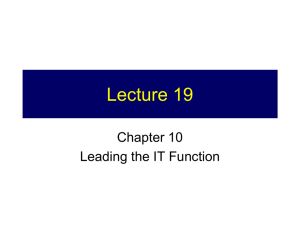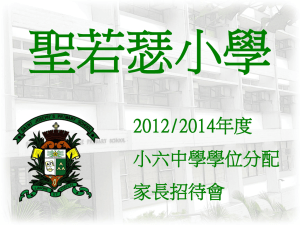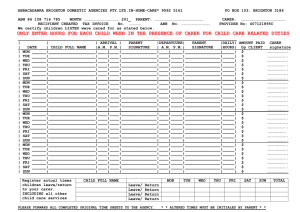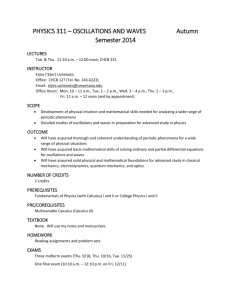SEED 300: Secondary Curriculum and Effective Teaching Fall 2013
advertisement
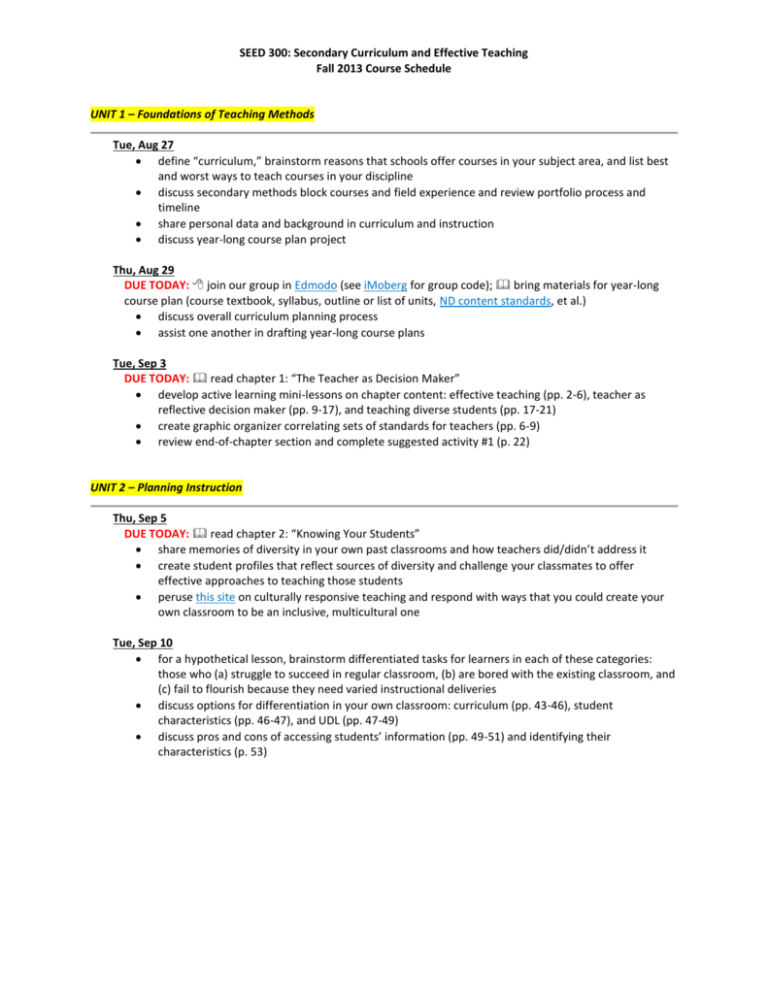
SEED 300: Secondary Curriculum and Effective Teaching Fall 2013 Course Schedule UNIT 1 – Foundations of Teaching Methods Tue, Aug 27 define “curriculum,” brainstorm reasons that schools offer courses in your subject area, and list best and worst ways to teach courses in your discipline discuss secondary methods block courses and field experience and review portfolio process and timeline share personal data and background in curriculum and instruction discuss year-long course plan project Thu, Aug 29 DUE TODAY: join our group in Edmodo (see iMoberg for group code); bring materials for year-long course plan (course textbook, syllabus, outline or list of units, ND content standards, et al.) discuss overall curriculum planning process assist one another in drafting year-long course plans Tue, Sep 3 DUE TODAY: read chapter 1: “The Teacher as Decision Maker” develop active learning mini-lessons on chapter content: effective teaching (pp. 2-6), teacher as reflective decision maker (pp. 9-17), and teaching diverse students (pp. 17-21) create graphic organizer correlating sets of standards for teachers (pp. 6-9) review end-of-chapter section and complete suggested activity #1 (p. 22) UNIT 2 – Planning Instruction Thu, Sep 5 DUE TODAY: read chapter 2: “Knowing Your Students” share memories of diversity in your own past classrooms and how teachers did/didn’t address it create student profiles that reflect sources of diversity and challenge your classmates to offer effective approaches to teaching those students peruse this site on culturally responsive teaching and respond with ways that you could create your own classroom to be an inclusive, multicultural one Tue, Sep 10 for a hypothetical lesson, brainstorm differentiated tasks for learners in each of these categories: those who (a) struggle to succeed in regular classroom, (b) are bored with the existing classroom, and (c) fail to flourish because they need varied instructional deliveries discuss options for differentiation in your own classroom: curriculum (pp. 43-46), student characteristics (pp. 46-47), and UDL (pp. 47-49) discuss pros and cons of accessing students’ information (pp. 49-51) and identifying their characteristics (p. 53) SEED 300: Secondary Curriculum and Effective Teaching Fall 2013 Course Schedule Thu, Sep 12 DUE TODAY: read chapter 3: “The Fundamentals of Planning” share responses: “If you were to observe in a ___ classroom for an hour, what evidence might you identify to indicate that the teacher had planned and was well prepared for teaching a lesson to the students?” explore academic content standards, Common Core standards, and the Framework for 21st-Century Learning and discuss how to use them as a basis for lessons list benefits to using backward design in planning curriculum and discuss how a teacher’s personal beliefs about teaching and learning would influence his/her approach to planning discuss field experience reflective journals Tue, Sep 17 DUE TODAY: submit field experience journal for Unit 1 (via Edmodo) analyze an analogy that illustrates the steps in the linear-rational approach and then develop your own analogies for the process take a field trip to Stoxen Library: examine sample resources for planning and teaching and report on how they might be used by a teacher draw connections between items (to be provided by Prof. Moberg) drawn from a hypothetical “grab bag” and the ideas and processes related to instructional planning Thu, Sep 19 DUE TODAY: read chapter 4: “Planning Lessons and Units” compare components of a unit plan (p. 113) to those required by the Pre-Service Teaching Handbook for a sample unit topic, plan the essential question (p. 112), the activities (introductory, developmental, and culminating—pp. 113-114), the assessments, and the resources discuss the benefits and disadvantages of multidisciplinary units prepare a T-chart on lesson preparation using the SIOP model (pp. 115-116) with “benefits to ELL students” in one column and “benefits to all students” in the other Tue, Sep 24 for a sample standard, “unpack” it to identify what students are expected to know and do—and create instructional objectives (both behavioral and descriptive—pp. 97-99) to match write instructional objectives in each of the main learning domains (pp. 99-105) compare components of a lesson plan (p. 108) to those required by the Pre-Service Teaching Handbook Thu, Sep 26 DUE TODAY: prepare for the test test on Units 1-2 (chapters 1-4) hear from current pre-service teacher: ___ SEED 300: Secondary Curriculum and Effective Teaching Fall 2013 Course Schedule UNIT 3 – Selecting Instructional Strategies Tue, Oct 1 DUE TODAY: submit field experience journal for Unit 2 (via Edmodo) DUE TODAY: read chapter 5: “Teacher-Centered Instructional Strategies” view sample year-long course plans and discuss last-minute questions on Thursday’s project in pairs, select a lesson topic and then identify examples of teaching strategies along the continuum of instructional approaches trade lesson topics and outline an instructional approach that demonstrates the gradual release of responsibility trade lesson topics and plan for the use of both deductive and inductive strategies in the lessons individually, create a lesson plan that demonstrates the six components of explicit instruction (p. 129) Thu, Oct 3 DUE TODAY: submit year-long course plan (via LiveText) select a unit topic and plan a seven-day unit that uses one of the direct instruction approaches per day demonstrate direct instruction approaches to the class discuss end-of-chapter questions (p. 143) Tue, Oct 8 DUE TODAY: read chapter 6: “Student-Centered Instructional Strategies” conduct “written discussion” on (a) why a teacher would select student-centered strategies and (b) what challenges a teacher may experience when using student-centered strategies in pairs, select two topics that could be taught in secondary courses and demonstrate how to apply an assigned concept attainment approach: (a) comparisons, (b) classifications, (c) metaphors, or (d) analogies compare and contrast the characteristics of inquiry/discovery lessons to those of projects, reports, and problems Thu, Oct 10 create a Venn diagram comparing and contrasting discussions with panels and debates in pairs, choose a course topic for which you would use cooperative learning, identify the roles you’d assign to students working in groups, and explain how you would prepare students to carry out their individual responsibilities discuss what learning centers might look like in your classrooms, how to prepare for them and utilize them with students, and what advantages and disadvantages they offer select a unit topic and plan a ten-day unit that uses one of the student-centered strategies per day discuss remaining course projects: unit plan utilizing effective instructional strategies, demonstration of an aligned lesson, and action research on instruction and assessment Tue, Oct 15 DUE TODAY: read chapter 7: “Strategies that Promote Understanding, Thinking, and Engagement” recall any unit topic from your year-long course plan and create a calendar grid showing the use of five strategies that promote student understanding on various days discuss all eight strategies from the chapter (pp. 170-183) and view related online resources (via our course page on iMoberg) break at 1:55 P.M.—spend remaining 20 minutes in a one-to-one conference with Prof. Moberg (to be scheduled individually) regarding action research project SEED 300: Secondary Curriculum and Effective Teaching Fall 2013 Course Schedule Thu, Oct 17 in small groups, plan how to help students use the ten critical thinking skills (p. 185) as they address a complex question (to be provided by Prof. Moberg) identify classroom examples of the application of student engagement strategies (p. 187) brainstorm topics that you will teach—for them, plan how to use the Sheltered Instruction Observation Protocol (SIOP)’s techniques for Strategies (p. 188) and Practice/Application (p. 189) Tue, Oct 22 DUE TODAY: submit unit plan utilizing effective instructional strategies (via LiveText) for a jigsaw reading-and-teaching activity, select a section from the handbook to accompany The Art and Science of Teaching (Marzano, 2007), chapter 2: “What will I do to help students effectively interact with new knowledge?” (to be provided by Prof. Moberg) o read, annotate, and respond to “Activity Box” o teach your section to us, engaging us in active learning o connect concepts in your section to concepts from our textbook (particularly ch. 5, 6, and 7) Thu, Oct 24 DUE TODAY: submit field experience journal for Unit 3 (via Edmodo) for a jigsaw reading-and-teaching activity, select a section from the handbook to accompany The Art and Science of Teaching (Marzano, 2007), chapter 3: “What will I do to help students practice and deepen their understanding of new knowledge?” (to be provided by Prof. Moberg) o read, annotate, and respond to “Activity Box” o teach your section to us, engaging us in active learning o connect concepts in your section to concepts from our textbook (particularly ch. 5, 6, and 7) Tue, Oct 29 for a jigsaw reading-and-teaching activity, select a section from the handbook to accompany The Art and Science of Teaching (Marzano, 2007), chapter 4: “What will I do to help students generate and test hypotheses about new knowledge?” (to be provided by Prof. Moberg) o read, annotate, and respond to “Activity Box” o teach your section to us, engaging us in active learning o connect concepts in your section to concepts from our textbook (particularly ch. 5, 6, and 7) Thu, Oct 31 DUE TODAY: prepare for the test test on Unit 3 (chapters 5-7) hear from current pre-service teacher: ___ SEED 300: Secondary Curriculum and Effective Teaching Fall 2013 Course Schedule UNIT 4 – Assessing and Reporting Student Performance Tue, Nov 5 DUE TODAY: read chapter 11: “Assessing Student Performance” brainstorm types of data that a school might collect to analyze the effectiveness of your courses specifically and your department generally—and then propose decisions and actions to be made based on analysis of those data (p. 283) share the types of diagnostic, formative, and summative assessment used in your field experience classroom—by you or your cooperating teacher (p. 284) discuss when norm-referenced and criterion-referenced evaluations are used in schools (p. 285) debate: Is it fair to all students to adapt assessments for ELLs or students with special needs? (p. 286) revise a sample course grading policy (to be provided by Prof. Moberg) to suit an effective framework for assessment (p. 288) propose both product and performance assessments for your own courses and demonstrate appropriate rating approaches (p. 293) for them discuss dispositions self-assessment Thu, Nov 7 DUE TODAY: submit dispositions self-assessment (via LiveText) and bring hard copy to class compare the book’s table of specifications (p. 295) with the department’s test blueprint (via iMoberg) create a test blueprint for a proposed test on this chapter and its intended outcomes (p. 281) complete “Suggested Activities—For Clinical Setting” #2 (p. 309) discuss what teachers do with the results of their students’ standardized tests (p. 307) respond to this article: “Are Standardized Tests for the Arts Even Possible?” Tue, Nov 12 DUE TODAY: read chapter 12: “Grading Systems, Marking, and Reporting” recall your own grades as a secondary student and propose how people utilized your grades for various functions (pp. 312-315) critique the secondary grading practices with which you’re familiar (e.g., your own teachers’, your current cooperating teachers’) in terms of confounding achievement grades (pp. 314-315) create subject-specific examples of each grading system (pp. 315-316) and explain the merits and drawbacks of each approach select a frame of reference for grading (pp. 319-322) and then develop a plan for determining a composite score for each of your students (pp. 317-319) Thu, Nov 14 DUE TODAY: submit field experience journal for Unit 4 (via Edmodo) develop a plan for reporting your students’ non-achievement outcomes (pp. 323-324) in an effective way without confounding their achievement grades describe the layout/setup of your gradebook (pp. 324-326) in light of your plan to determine students’ composite scores (from Tuesday) debate: The grade that I record for a student on his/her report card or in his/her cumulative record file (pp. 326-328) is less important than my ability to explain aloud what he/she has learned from me, if someone were to ask. examine online resources related to grading (via iMoberg) discuss the ideal composite score for you as a professional educator—how you would like to be evaluated as a teacher when it comes time for an administrator to do that SEED 300: Secondary Curriculum and Effective Teaching Fall 2013 Course Schedule Tue, Nov 19 DUE TODAY: prepare a demonstration of an aligned lesson deliver (and explain) a portion of a lesson that will demonstrate the lesson plan’s alignment of content standard, instructional objective, teaching and learning strategies, and means of assessment 1:00-1:15 Mamie 1:36-1:51 Josh 1:18-1:33 Tony 1:54-2:09 J.L. UNIT 5 – Managing Instruction and the Classroom Thu, Nov 21 DUE TODAY: read chapter 8: “Managing Lesson Delivery” demonstrate and explain the use of whole-group instruction (p. 195), within-class grouping (p. 197), or independent work (p. 197) create a student academic accountability plan (p. 198) microteaching: demonstrate the effective management of the parts of a lesson: the beginning (p. 199), the middle (p. 203), or the end (p. 207) demonstrate the effective management of seatwork (p. 209), prevention of misbehavior (p. 212), movement through a lesson (p. 213), maintenance of group focus (p. 214), and maintenance of student attention and involvement (p. 214) discuss ways that the SIOP model (p. 216) would benefit both English language learners and other students in your classroom Tue, Nov 26 DUE TODAY: read chapter 9: “Classroom Management” referring to the areas of responsibility (pp. 225-226), share and stories of classroom management from your field experience classrooms in pairs, choose the top three principles for working with students and preventing misbehavior (pp. 227-228) and justify your choices to the class do the same for an assigned set of preparations: management (pp. 228-231), instructional (pp. 231233), and misbehavior (pp. 234-235) discuss the preparation that you will do RE: assessments and records (pp. 233-234) and the first day of school (p. 236) view two secondary classroom tours (here and here) brainstorm types of classroom spaces on our campus and discuss how you would organize one in terms of arrangement, floor space, storage, and display space (pp. 236-239) consider various seating arrangement options (here and here) design sets of rules and matching procedures (pp. 239-245) for different scenarios: (A) for a class of young students and one of older students; (B) for an activity-oriented classroom and a seatworkoriented one; and (C) for a teacher-centered classroom and a student-centered one enact scenarios that demonstrate withitness (p. 245), emotional objectivity (p. 246), high dominance (p. 246), high cooperation (p. 247), appropriate interaction (p. 248), and four kinds of reinforcers (p. 249) Thu, Nov 28 no class – Thanksgiving SEED 300: Secondary Curriculum and Effective Teaching Fall 2013 Course Schedule Tue, Dec 3 DUE TODAY: read chapter 10: “Classroom Discipline” discuss your own students’ misbehaviors in terms of types (p. 256) and causes (p. 257) role-play a student displaying a specific misbehavior (to be assigned by Prof. Moberg) while a classmate role-plays a teacher leading a lesson—then discuss the teacher’s response in terms of the three-step response plan (p. 260) discuss the Wongs’ idea of having a misbehaving student write an Action Plan and then using that as the basis for contacting his/her parents about the misbehavior (via iMoberg) discuss the “practices to avoid” (pp. 269-270) that you have witnessed or even done yourself select a guideline for punishment (pp. 270-271) and exemplify its use in your own future classroom select a chronic misbehavior (pp. 271-275) for which you like our book’s advice and share with the class share stories of bullying—of all five types (pp. 276-277)—from your experience as a student or teacher examine online resources related to classroom management and discipline (via iMoberg) Thu, Dec 5 DUE TODAY: submit field experience journal for Unit 5 (via Edmodo) for a jigsaw reading-and-teaching activity, select a section from the handbook to accompany The Art and Science of Teaching (Marzano, 2007), chapter 5: “What will I do to engage students?” (to be provided by Prof. Moberg) o read and respond to “ALL” sections (pp. 157-158, 167-168, and 187-188)) o for your assigned section, read and annotate it and then respond to “Activity Box” o teach your section to us, engaging us in active learning o connect concepts in your section to concepts from our textbook Tue, Dec 10 DUE TODAY: submit action research on instruction and assessment (via LiveText) for a jigsaw reading-and-teaching activity, select a section from the handbook to accompany The Art and Science of Teaching (Marzano, 2007), chapter 8: “What will I do to establish and maintain effective relationships with students?” (to be provided by Prof. Moberg) o read and respond to “ALL” sections (pp. 251-252 and 261-262) o for your assigned section, read and annotate it and then respond to “Activity Box” o teach your section to us, engaging us in active learning o connect concepts in your section to concepts from our textbook hear from current pre-service teacher: ___ SEED 300: Secondary Curriculum and Effective Teaching Fall 2013 Course Schedule UNIT 6 – Working with Others Thu, Dec 12 DUE TODAY: read chapter 13: “Collaborating with Colleagues and Families” describe scenarios in which you would collaborate as a teacher—based on the “Why?” and “With Whom?” items on pp. 335-337 examine online resources related to professional learning communities (via iMoberg) determine which of the reasons for working with families (pp. 340-342) are addressed by contacts early in the school year and which by contacts later in the year discuss how our book’s information on contacting parents (pp. 343-356) compares to related info that you have learned in other education courses respond to the “What Would You Decide?” scenarios on pp. 343, 351, and 353 and the case study on p. 355 examine online resources related to the Praxis II: PLT (Principles of Learning and Teaching) exam (via iMoberg) FINAL EXAMINATION Recall from the syllabus that all students must take the final examination in order to receive a grade for the course. During final exam week, we meet at a different time and day from our regular class sessions (but still in our usual classroom): Mon, Dec 16 – 2:00-4:00 P.M. DUE TODAY: prepare for the test test on Units 4-5 (chapters 8-12) but also with questions on material from earlier in the course
